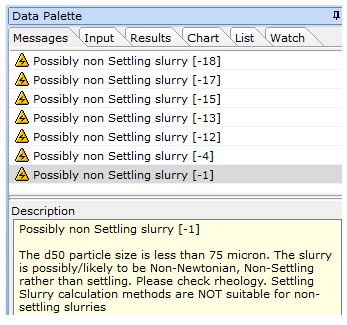This message is enunciated based on the slurry data definition, more specifically, the particle size (see image below).

The warning is issued to prompt the user into checking the solids data or rheology data. If you don't already have rheology data, it would be advisable to source this to determine the physics of the fluid. If the fluid is deemed non-settling, you can model the fluid as a non-Newtonian fluid.
In a case where you have defined the d50 or d50 and d85 values, the warning message indicates that the slurry may in fact be non-settling as the defined d50 particle size may be less than 75 micron (0.075mm).
Alternatively, in a case where you have defined the PSD (particle size distribution) values, the warning message indicates that the slurry may in fact be non-settling as the resultant d50 particle size calculated based on the defined PSD is less than 75 micron (0.075mm).
The value of 75 micron (0.075mm) is a useful guide and is quoted in reference literature as a means of helping define a slurry flow characteristic.
We can cross-check the slurry using other means. If we refer to the Metso data (see image below), we can check your defined d50 particle size against the flowing velocity. This will give an indication of the slurry characteristics, i.e. homogeneous suspension etc.

Another check - this time of the GIW data (see image below) shows that the particle d50 and specific gravity will also give an indication of the slurry characteristics.

Note, other literature sources refer to slurries exhibiting non-settling flow characteristics when the typical particle size is circa. sub 40 micron. The particles are basically held in suspension within the "carrier" fluid.
You may notice under these conditions, the calculated result for "Deposition Velocity" is not shown. This would be due to the solver determining that the slurry may actually be non-settling and as such, doesn't feature a settling velocity.
At this stage, we would recommend seeking further information (rheology data, detailed lab analysis/report) on the solids/slurry and the system.